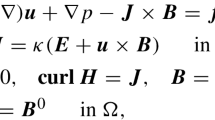Abstract
In this work we use Grad’s 13–moment approximation to study a stationary shock wave in dilute gases. The conservation equations valid across the shock wave profile depend on the constitutive relations for the viscous tensor and the heat flux. The Grad’s 13-moment equations are taken to obtain the set of constitutive equations and the conservation equations are closed and solved. In addition, such constitutive equations can be written in terms of nonlinear transport coefficients depending on the velocity gradient. Their structure shows that the temperature gradient and the gradient of velocity produce non-trivial contributions in the heat flux as well as in the viscous tensor. A comparison with experiments and some other models is done.




Similar content being viewed by others
References
Salas MD (2007) The curious events leading to the theory of shock waves. Shock Waves 16(6):477–487
Gilbarg D (1951) The existence and limit behavior of the one-dimensional shock layer. Am J Math 73:256–274
Taylor GI (1910) The conditions necessary for discontinuous motion in gases. Proc R Soc London Series A 84:371–377
Becker R (1922) Stosswelle und detonation. Z Phys 8:321–362
Becker R (1929) Impact waves and detonation, parts i and ii. Technical report 506, national advisory committee for aeronautics, Washington. From Zeitschrift für Physick, Volume VIII
Thomas LH (1944) Note on Becker’s theory of the shock front. J Chem Phys 12:449–453
Johnson BM (2013) Analytical shock solutions at large and small Prandtl number. J Fluid Mech 726:4
Johnson BM (2014) Closed-form shock solutions. J Fluid Mech 745:1
Myong RS (2014) Analytical solutions of shock structure thickness and asymmetry in Navier-Stokes/fourier framework. AIAA J 52:1075–1080
Uribe FJ, Velasco RM (2019) Exact solutions for shock waves in dilute gases. Phys Rev E 100(2):023118
Grad H (1952) The profile of a steady plane shock wave. Comm Pure Appl Math 5(3):257–300
Holway LH (1964) Existence of kinetic theory solutions to the shock structure problem. Phys Fluids 7:911–913
Gilbarg D, Paolucci D (1953) The structure of shock waves in the continuum theory of fluids. J Ration Mech Anal 2:617–642
Weiss W (1995) Continuous shock structure in extended thermodynamics. Phys Rev E 52:5760–5763
Anile AM, Majorana A (1981) Shock structure for heat conducting and viscous fluids. Meccanica 16:149–156
Jou D, Pavon D (1991) Nonlocal and nonlinear effects in shock-waves. Phys Rev A 44:6496–6502
Müller I, Ruggeri T (1998) Rational extended thermodynamics. Springer, New York
Cai Z, Torrilhon M (2019) On the Holway-Weiss debate: convergence of the grad-moment-expansion in kinetic gas theory. Phys Fluids 31(12):126105
Boillat G, Ruggeri T (1998) On the shock structure problem for hyperbolic system of balance laws and convex entropy. Contin Mech Thermodyn 10:285–292
Struchtrup H, Torrilhon M (2003) Regularization of Grad’s 13 moment equations: derivation and linear analysis. Phys Fluids 15:2668–2680
Timokhin MY, Struchtrup H, Kokhanchik AA, Bondar YA (2017) Different variants of R13 moment equations applied to the shock-wave structure. Phys Fluids 29:037105
AlGhoul M, Eu BC (1997) Generalized hydrodynamics and shock waves. Phys Rev E 56:2981–2992
Myong RS (2014) On the high Mach number shock structure singularity caused by overreach of Maxwellian molecules. Phys Fluids 26(5):056102
Zinner CP, Öttinger HC (2019) Numerical stability with help from entropy: solving a set of 13 moment equations for shock tube problem. J Non-Equilib Thermodyn 44(1):43–69
Agrawal A, Kushwaha HM, Jadhav RS (2020) Microscale flow and heat transfer. Springer, Switzerland
García-Colín LS, Velasco RM, Uribe FJ (2004) Inconsistency in the Moment’s method for solving the Bolztmann equation. J Non-Equilib Thermodyn 29:257–277
Uribe FJ, García-Colín LS (1999) Nonlinear viscosity and Grad’s method. Phys Rev E 60:4052
Velasco RM, Uribe FJ (2021) A study on the Holian conjecture and linear irreversible thermodynamics for shock-wave structure. Wave Motion 100:102684
Chapman S, Cowling TG (1970) The mathematical theory of non-uniform gases. Cambridge University Press, Cambridge
Muntz EP, Harnett NL (1969) Molecular velocity distribution function measurements in a normal shock wave. Phys Fluids 12(10):2027–2035
Hurly JJ, Mehl JB (2007) \(^4\)He thermophysical properties: new Ab initio calculations. J Res Natl Stand Technol 112:75–94
Greenshields CJ, Reese JM (2007) The structure of shock waves as a test of Brenner’s modifications to the Navier-Stokes equations. J Fluid Mech 580:407–429
Velasco RM, Uribe FJ (2019) Shock-wave structure according to a linear irreversible thermodynamic model. Phys Rev E 99(2):023114
Velasco RM (2020) Uribe FJ (2020) Erratum: shock-wave structure according to a linear irreversible thermodynamic model [Phys Rev E 99: 023114 (2019)]. Phys Rev E 1:019903
Uribe FJ, Velasco RM (2018) Shock-wave structure based on the Navier-Stokes-fourier equations. Phys Rev E 97:043117
Velasco RM, García-Colín LS, Uribe FJ (2011) Entropy production: its role in non-equilibrium thermodynamics. Entropy 13:82–116
Uribe FJ, Velasco RM (2016) Einstein relation for electrons in an electric field. J Stat Phys 162:242–266
Acknowledgements
We would like to thank the referees for their insigths and comments.
Author information
Authors and Affiliations
Corresponding author
Ethics declarations
Conflict of interest
The authors declare that they have no conflict of interest.
Additional information
Publisher's Note
Springer Nature remains neutral with regard to jurisdictional claims in published maps and institutional affiliations.
Rights and permissions
Springer Nature or its licensor holds exclusive rights to this article under a publishing agreement with the author(s) or other rightsholder(s); author self-archiving of the accepted manuscript version of this article is solely governed by the terms of such publishing agreement and applicable law.
About this article
Cite this article
Uribe, F.J., Velasco, R.M. Nonlinear transport coefficients from Grad’s 13–moment approximation. Meccanica 58, 1099–1108 (2023). https://doi.org/10.1007/s11012-022-01565-x
Received:
Accepted:
Published:
Issue Date:
DOI: https://doi.org/10.1007/s11012-022-01565-x




